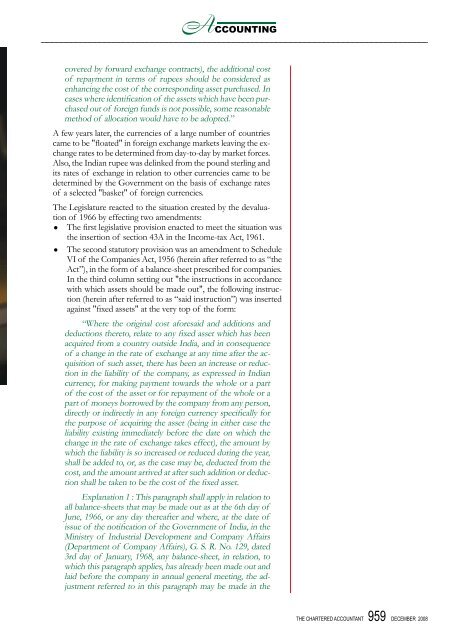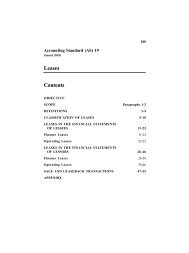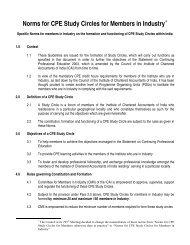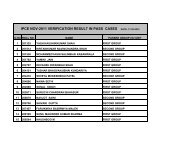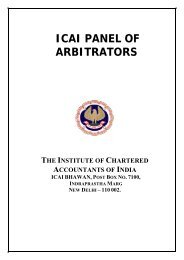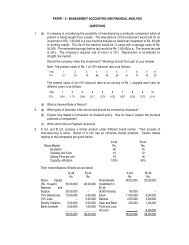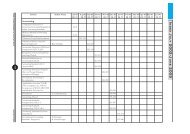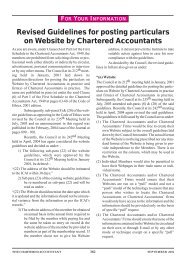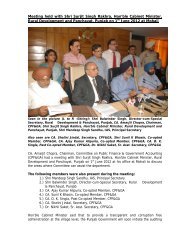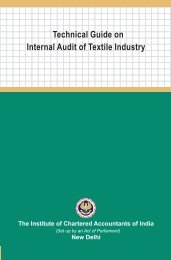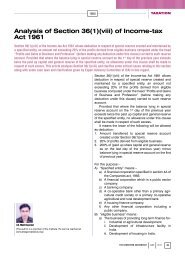The Chartered Accountant
The Chartered Accountant
The Chartered Accountant
You also want an ePaper? Increase the reach of your titles
YUMPU automatically turns print PDFs into web optimized ePapers that Google loves.
ACCOUNTING<br />
covered by forward exchange contracts), the additional cost<br />
of repayment in terms of rupees should be considered as<br />
enhancing the cost of the corresponding asset purchased. In<br />
cases where identification of the assets which have been purchased<br />
out of foreign funds is not possible, some reasonable<br />
method of allocation would have to be adopted.”<br />
A few years later, the currencies of a large number of countries<br />
came to be "floated" in foreign exchange markets leaving the exchange<br />
rates to be determined from day-to-day by market forces.<br />
Also, the Indian rupee was delinked from the pound sterling and<br />
its rates of exchange in relation to other currencies came to be<br />
determined by the Government on the basis of exchange rates<br />
of a selected "basket" of foreign currencies.<br />
<strong>The</strong> Legislature reacted to the situation created by the devaluation<br />
of 1966 by effecting two amendments:<br />
l <strong>The</strong> first legislative provision enacted to meet the situation was<br />
the insertion of section 43A in the Income-tax Act, 1961.<br />
l <strong>The</strong> second statutory provision was an amendment to Schedule<br />
VI of the Companies Act, 1956 (herein after referred to as “the<br />
Act”), in the form of a balance-sheet prescribed for companies.<br />
In the third column setting out "the instructions in accordance<br />
with which assets should be made out", the following instruction<br />
(herein after referred to as “said instruction”) was inserted<br />
against "fixed assets" at the very top of the form:<br />
“Where the original cost aforesaid and additions and<br />
deductions thereto, relate to any fixed asset which has been<br />
acquired from a country outside India, and in consequence<br />
of a change in the rate of exchange at any time after the acquisition<br />
of such asset, there has been an increase or reduction<br />
in the liability of the company, as expressed in Indian<br />
currency, for making payment towards the whole or a part<br />
of the cost of the asset or for repayment of the whole or a<br />
part of moneys borrowed by the company from any person,<br />
directly or indirectly in any foreign currency specifically for<br />
the purpose of acquiring the asset (being in either case the<br />
liability existing immediately before the date on which the<br />
change in the rate of exchange takes effect), the amount by<br />
which the liability is so increased or reduced during the year,<br />
shall be added to, or, as the case may be, deducted from the<br />
cost, and the amount arrived at after such addition or deduction<br />
shall be taken to be the cost of the fixed asset.<br />
Explanation 1 : This paragraph shall apply in relation to<br />
all balance-sheets that may be made out as at the 6th day of<br />
June, 1966, or any day thereafter and where, at the date of<br />
issue of the notification of the Government of India, in the<br />
Ministry of Industrial Development and Company Affairs<br />
(Department of Company Affairs), G. S. R. No. 129, dated<br />
3rd day of January, 1968, any balance-sheet, in relation, to<br />
which this paragraph applies, has already been made out and<br />
laid before the company in annual general meeting, the adjustment<br />
referred to in this paragraph may be made in the<br />
THE CHARTERED ACCOUNTANT 959 DECEMBER 2008


